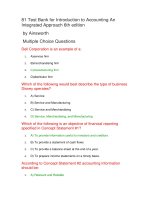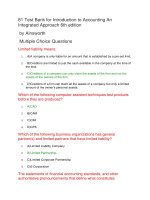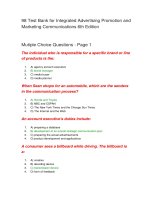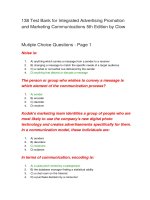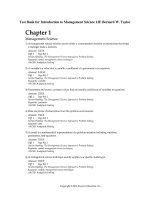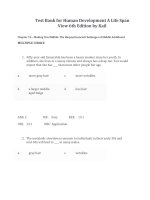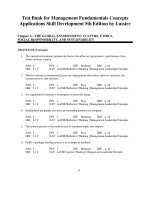Download test bank for introduction to maternity and pediatric nursing 6th edition by leifer
Bạn đang xem bản rút gọn của tài liệu. Xem và tải ngay bản đầy đủ của tài liệu tại đây (670.41 KB, 35 trang )
Link download full: />
TEST BANK FOR INTRODUCTION
TO MATERNITY AND PEDIATRIC
NURSING 6TH EDITION BY
LEIFER
Chapter 20: The Adolescent
MULTIPLE CHOICE
1. When assessing a 13-year-old boy, the nurse would keep in
mind physical changes in the pubertal male begin with:
a.
development of axillary and facial hair.
b.
enlargement of penis.
c.
enlargement of testicles.
d.
pigmentation of the scrotum.
ANS: C
In boys, pubertal changes begin with enlargement of the testicles and
internal structures.
DIF:
Cognitiv
Com
e Level:
preh
ensi
on
REF
:
p. 454
TOP: Physical Development
Process Step: Assessment
OBJ:
2
KEY:
Nursing
MSC: NCLEX: Health Promotion and Maintenance: Growth
and Development
2. A 13-year-old boy states, “The girls in my class towe nurse’s most informative response
would be:
a.
“It may seem that way becau a growth spurt 2
years earl
b.
“Perhaps your parents are n exceptionally tall.”
c.
“Boys usually experience a year earlier
than girls.”
d.
“You may feel short, but yo average height for
your age
ANS: A
Although the age for growth spurts during puberty varies, growth spurts occur
2 years earlier for girls than for boys.
DIF
:
Cognitive Level: Application
TOP: Physical Development
Process Step: Implementation
REF:
p. 462
KEY:
MSC: NCLEX: Health Promotion and Maintenance: Growth and
Development
OBJ:
2
Nursing
3. A parent comments that her adolescent daughter seems to be daydreaming a
lot. The nurse understands that this behavior indicates she is:
a.
bored.
b.
not getting enough rest.
c.
trying to block out stress and anxiety.
d.
mentally preparing for real situations.
ANS: D
Daydreaming allows adolescents to act out in their imaginations what will be
said or done in certain situations. This helps them to prepare for and cope
with interactions with others.
DIF
:
TOP:
Cognitive Level: Analysis
Development-Daydreams
REF:
p. 460
OBJ:
KEY Nursing Process Step:
:
Assessment
MSC: NCLEX: Health Promotion and Maintenance: Growth
and Development
4. The nurse planning a safety program for high school students should
understand that most accidental deaths in adolescence are related to:
3
a.
firearms.
b.
automobiles.
c.
drowning.
d.
diving injuries.
ANS: B
The chief safety hazard for the adolescent is automobiles.
DIF
:
TOP:
Cognitive Level: Knowledge
Safety
REF:
p. 465
OBJ:
14
KEY: Nursing Process Step: Planning
MSC: NCLEX: Health Promotion and Maintenance: Growth
and Development
5. A 16-year-old excitedly tells his parents that he was offered a part-time
job. Which response represents an effective problem-solving approach for
his parents?
a.
“Your studiesoimportantaretofr you to have
a part-time job.”
b.
“When we went to high schoo were the
adolescent’s prior
c.
“We want you to put your ea savings account.”
d.
“How do you think you will school work and
a job?”
ANS: D
An effective approach to help adolescents learn to solve problems is
for parents to guide them in exploring alternatives.
DIF: Cognitive Level: Application
box
OBJ: 3
Evaluation
TOP:
Parenting
REF:
p. 463, Health Promotion
KEY: Nursing Process Step:
MSC: NCLEX: Health Promotion and Maintenance: Growth
and Development
6. One psychosocial task of adolescence on which the nurse must
focus when planning care is the development of a sense of:
a.
initiative.
b.
industry.
c.
identity.
d.
involvement.
ANS: C
Psychosocial milestones that must be accomplished during adolescence
include the five Is— image of self, identity, independence,
interpersonal relationships, and intellectual maturity.
DIF
:
Cognitive Level: Knowledge
OBJ:
3
KEY :
Nursing Process Step: Planning
TOP:
REF:
p. 456, Box 20-1
Psychosocial Development
MSC: NCLEX: Health Promotion and Maintenance: Growth
and Development
7. A 13-year-old girl tells the school nurse that she is getting fat, especially in
her hips and legs. The understanding by the nurse that would best guide
the response is:
a.
many adolescents are unaware of proper
nutrition.
b.
adolescents of this age become less
active and should eat fewer calories.
c.
puberty is often preceded by fat deposits
in these areas.
d.
as soon as menarche occurs, she will lose
this excess weight.
ANS: C
Secondary sexual characteristics become apparent before menarche. Fat
is deposited in the hips, thighs, and breasts, causing them to enlarge.
DIF
:
Cognitive Level: Analysis
OBJ:
2
KEY :
Nursing Process Step: Planning
TOP:
REF:
p. 455, Box 20-2
Physical Development
MSC: NCLEX: Health Promotion and Maintenance: Growth
and Development
8. The school nurse is planning a program for girls about the physical
changes of puberty; this program should be directed to girls of the age of
_____ years.
a.
16
b.
14
c.
12
d.
10
ANS: D
Because puberty can occur in girls as early as age 10 years, instruction must be
given by that age.
DIF
:
Cognitive Level: Comprehension
REF:
TOP: Physical Development
Process Step: Planning
p. 455
KEY:
OBJ:
2
Nursing
MSC: NCLEX: Health Promotion and Maintenance: Growth
and Development
9. The statement made by a parent indicating understanding about helping a
13-year-old manage his allowance is:
a.
“I set amounts he can earn chores.”
b.
“I give him a certain amoun each day.”
c.
“I put money into his bank month.”
d.
“I told him to ask me when money.”
ANS: A
If money is simply handed out as requested, it is difficult to develop
responsibility for finances and money management. The older adolescent is able
to get a job. The younger adolescent can earn money by doing particular chores.
DIF
:
Cognitive Level: Application
TOP:
Development-Responsibility
REF:
p. 460
OBJ:
KEY Nursing Process Step:
:
Evaluation
MSC: NCLEX: Health Promotion and Maintenance: Growth
and Development
10.
The nurse suggests a good dietary source of zinc for an
adolescent who is a vegetarian would be:
a.
green, leafy vegetables.
b.
citrus fruits.
c.
nuts.
d.
enriched breads.
ANS: C
Zinc is essential for growth and sexual maturation in adolescence. Good
vegetable sources include nuts, legumes, and wheat germ.
5
DIF
:
TOP:
Cognitive Level: Comprehension
Nutritio
n
REF:
p. 464
OBJ:
11
KEY: Nursing Process Step: Assessment
MSC: NCLEX: Health Promotion and Maintenance: Growth
and Development
11.
An adolescent’s parent comments, “My son seems preoccupied with his
appearance these days. Is thi nurse’s best response would be:
a.
“It is his attempt to expre individualism.”
b.
“His preoccupation with his normal.”
c.
“He is probably troubled wi changes.”
d.
“This shows that he has- a p image.”
ANS: B
Preoccupation with self-image is normal and accounts for the constant
primping of adolescents.
DIF: Cognitive Level: Application
REF:
p. 458, Table 20-1
OBJ:
14
TOP:
Development
KEY: Nursing Process Step: Planning
MSC: NCLEX: Health Promotion and Maintenance: Growth
and Development
12.
Foods that would be a healthy choice for an adolescent who just
finished playing in a strenuous game would be:
a.
a cheeseburger and soda.
b.
a hot fudge sundae.
c.
two sausage and egg breakfast
sandwiches and orange juice.
d.
a bagel and skim milk.
ANS: D
A bagel provides a rapid supply of carbohydrates to the muscles, and
skim milk provides a slow release of carbohydrates to the muscles.
DIF
:
TOP:
Cognitive Level: Application
Nutritio
n
REF:
p. 464
KEY Nursing Process Step: Assessment
:
OBJ:
11
MSC: NCLEX: Health Promotion and Maintenance: Growth
and Development
13.
When planning to answer a 16-year-old girl’s questions abou menstruation, the
nurse must consider cognitive development.
According to Piaget, the cognitive aspect that is developed
during adolescence is the ability to:
a.
view a situation from multiple
perspectives.
b.
focus more on the past than
present situations.
c.
exercise concrete reasoning.
d.
consider hypothetical situations.
ANS: D
According to Piaget, in the formal operations stage adolescents have the
ability to think abstractly.
DIF
:
Cognitive Level: Comprehension
OBJ:
4
KEY :
Nursing Process Step: Planning
TOP:
REF:
p. 452, Box 20-1
Cognitive Development
MSC: NCLEX: Health Promotion and Maintenance: Growth
and Development
14.
A girl tells the nurse that she and her best friend belong to the
popular
clique.
She states,
“I love
Lady
Gaga,
and
singer.” The nurse recognizes the girl’s statement peer relationships in:
a.
early adolescence.
b.
middle adolescence.
c.
late adolescence.
d.
the entire adolescent period.
ANS: A
Cliques of unisex friends, having a best friend, and hero worship are
characteristics of the early adolescent.
DIF
:
Cognitive Level: Comprehension
OBJ:
8
KEY :
Nursing Process Step: Assessment
TOP:
REF:
p. 454, Table 20-1
Social Development
MSC: NCLEX: Health Promotion and Maintenance: Growth
and Development
15.
The nurse is leading a discussion group with parents of
adolescents. One parent comments, “My son can’t do checking with his friends first. My
opinion doesn’ nurse would formulate a response on the knowledge that this behavior is:
a.
unusual for adolescent boys.
b.
often more apparent in boys than girls.
c.
a normal phenomenon
during adolescence.
d.
suggestive of feelings of low self-worth.
ANS: C
Parents may need help understanding that the adolesce conformity is necessary for moving
away from dependence and obtaining approval from persons outside the nuclear family.
DIF: Cognitive Level: Application
TOP: Peer Relationships
Planning
REF:
p. 459
OBJ:
KEY: Nursing Process Step:
MSC: NCLEX: Health Promotion and Maintenance: Growth and
Development
16.
a.
The nurse points out to a group of parents that the most positive
developmental significance of a peer group to the adolescent is that
the group serves as a(n):
social outlet.
9
b.
association to blur personal identity.
c.
platform for “group think.”
d.
initial separation from family.
ANS: D
Being a member of a peer group and communicating with and seeking
approval from this group are the first separation from the family.
DIF: Cognitive Level: Analysis
OBJ:
N/A
9
TOP:
Peer Groups
REF:
p. 458, Table 20-1
KEY: Nursing Process Step:
MSC: NCLEX: Health Promotion and Maintenance: Growth and
Development
17.
The nurse understands that the adolescent’s av orientation to be based on Freud’s
theory, which d as the __________ stage.
a.
conceptual
b.
genital
c.
glandular
d.
pubertal
ANS: B
Freud describes the adolescent period as genital.
DIF
:
OBJ:
Cognitive Level: Knowledge
4
TOP:
REF:
Freud
p. 452, Box 20-1
KEY Nursing Process Step:
:
Assessment
MSC: NCLEX: Health Promotion and Maintenance: Growth
and Development
18.
The nurse using the PACE interview guide for persons at risk for
substance abuse arrives at a score of 2 for an adolescent patient. The nurse
should assess this score as:
a.
nonindicative of potential substance
abuse.
b.
normal experimentation of the adolescent.
c.
need to schedule another PACE interview in
3 months.
d.
indication for referral for counseling.
ANS: D
The PACE guide recommends that a score of 2 or higher would suggest
the need for a referral for counseling about substance abuse.
DIF
:
TOP:
Cognitive Level: Knowledge
PACE Interview
REF:
p. 466
KEY Nursing Process Step:
:
Assessment
MSC: NCLEX: Health Promotion and Maintenance: Growth
and Development
19.
The nurse explains that adolescent acne is the result of:
a.
ineffective sweat glands.
b.
oily skin.
c.
inadequate hygiene.
d.
a poor diet.
OBJ:
ANS: B
Adolescent acne is the result of overactive sweat glands and oily skin.
14
DIF: Cognitive Level: Comprehension
REF:
p. 454
OBJ:
14
TOP: Acne
KEY: Nursing Process Step: Implementation
MSC: NCLEX: Health Promotion and Maintenance: Growth
and Development
20.
The nurse suggests the use of “I” messages to parent’s feeling to an adolescent.
The most approp “I” message is:
a.
“I feel frightened when you your curfew.”
b.
“I am your mother, and I in observe your
curfew.”
c.
“I am sick and tired of you late.”
d.
“I expect you to show me pr
ANS: B
This is the only statement that associates the parent the adolescent behavior that is
not aggressive or accusatory.
DIF
:
box
OBJ:
Cognitive Level: Analysis
1
TOP:
“I”
REF:
statements
p. 463, Health Promotion
